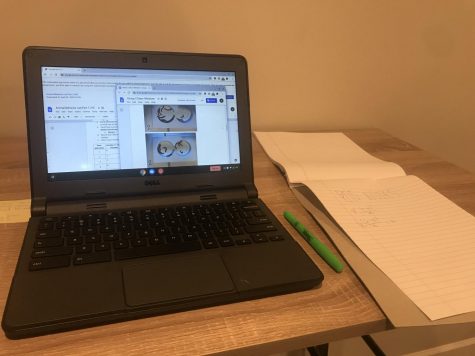Your donation will allow our student journalists to continue their work. You may become a PATRON by making a donation at one of these levels: White/$30, Black/$50, Gold/$100. Patron names will be published in the print newsmagazine, on the website and once per quarter on our social media accounts.
Science labs aim to help students get away from computer
April 6, 2020

Students in science classes have to do some labs online. Teachers like Scott Holtmann use online resource to allow students to see actual lab results through photos and videos.
Science classes have also had to adjust to the new shift in schooling. A key component of science classes revolves around the ability of students and teachers being able to work through lab activities. Because they are no longer able to complete these together, labs have been changed to adapt to the materials students have available to them.
“One of the major labs for our current unit [in Advanced Placement (AP) Biology] is the animal behavior lab. For this, a teacher in the AP [Biology] District Professional Learning Community had her kids at home do the lab, and she took pictures [that she shared with the community],” Scott Holtmann, AP and Honors Biology teacher, said. “This gives you all a chance to see the observations and perform the statistical analysis. In short, the focus has to shift a little bit from physically performing it while still maintaining focus on the skills such as data analysis, argumentation and statistical tests.”
Holtmann’s goal has been to keep his students connected to biology while also remaining safe under quarantine.
“My overall goal is to keep my students doing so biology and stay connected through email and weekly zoom chats. I definitely keep accessibility in mind when I’m assigning labs. For example, I found a neat lab where students take a vegetable and get it to sprout roots, however, I opted not to pick this because I did not want to encourage any unnecessary trips to the grocery store while we are supposed to be practicing social distancing,” Holtmann said.
In chemistry, the shift has also prevented the majority of regularly scheduled labs from happening.
“We are not doing labs for regular chemistry. We looked at a lot of virtual labs and didn’t find anything that was engaging or would enhance classroom learning,” Shannon Campbell, chemistry and AP Physics 1 teacher, said.
A lab that can still occur in regular chemistry is set in the acids and bases unit, where Campbell has decided to give an option for students to test objects in their house using a homemade acid-base indicator.
“When we get to acids and bases, you can make an acid-base indicator with red cabbage, so I was thinking of doing an interactive class where students tell me what household products they want to know the pH of and then discuss why the results are the way they are. I was going to show them how to make it themselves if they wanted to test things in their own house,” Campbell said.
For physics, the majority of labs can still be done using phones or Google apps.
“Most students have a timer on their phone and they have a measuring tape/ruler at their house so we can do labs that involve motion. That allows us to do a lot of different types of labs that cover a lot of topics in both AP Physics 1 and 2. Also, Google has an app called Science Journal that accesses the sensors in your phone. The app allows you to make graphs of your own motion,” Campbell said.
The labs planned in chemistry and physics all have one goal: to get students up and away from the computers.
“All the lab activities we have planned are to get them up and moving and not in front of a screen,” Campbell said.
Holtmann has also been using labs to get his students out of their homes and into the outdoors.
“In my Honors Biology class, it’s actually opening doors. I’m sending students outside to make observations of plants and document their observations with pictures. The getting outside aspect of this is much more difficult in a normal class setting, so we’re trying our best to turn our lemons into lemonade,” he said.
Several students in science classes, though, are having a difficult time keeping up with the labs due to less face-to-face time with their classmates.
“I think ALP is making the labs less interactive and engaging. I don’t like them this way as much because I don’t get insight from my lab partners as easily and the labs are simplified and partially done by the teacher,” junior Olivia Moran said about her AP Biology class.
Others are enjoying the ability to see firsthand how different sciences impact the world around them firsthand.
“I like having physics labs out of the classroom because it gives me a chance to apply in my daily life. In the classroom we have all this equipment and things that most people don’t have at home, so, being at home, I get to use tools on my phone to investigate the world around me,” Arjun Suresh, a sophomore in AP Physics 1, said.